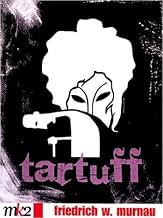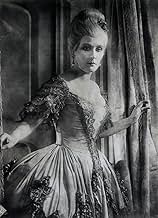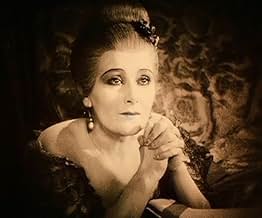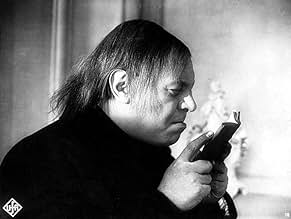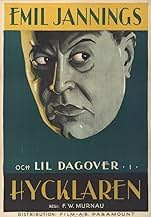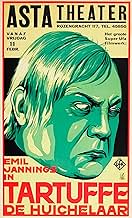IMDb-BEWERTUNG
7,1/10
2866
IHRE BEWERTUNG
Ein junger Mann zeigt seinem millionenschweren Großvater einen Film, der auf Molières Tartuffe basiert, um die heuchlerische Haushälterin des alten Mannes zu entlarven, die es auf sein Erbe ... Alles lesenEin junger Mann zeigt seinem millionenschweren Großvater einen Film, der auf Molières Tartuffe basiert, um die heuchlerische Haushälterin des alten Mannes zu entlarven, die es auf sein Erbe abgesehen hat.Ein junger Mann zeigt seinem millionenschweren Großvater einen Film, der auf Molières Tartuffe basiert, um die heuchlerische Haushälterin des alten Mannes zu entlarven, die es auf sein Erbe abgesehen hat.
Empfohlene Bewertungen
Personally I think the other reviewers have been way too hard on this film, and I certainly don't agree that it is "extremely average", "throwaway" or "plain and forgettable". OK - it's not his best by a long shot, but Murnau was such a talented directer/artist that even his weaker films urinate all over the films of most other directors. I thought that the 'film within a film' structure of it worked brilliantly. The cast were all excellent in their acting. The film is pretty great visually too (as one would expect from Murnau) - the 'outer' film is shot in a crisp, modernist style, with adventurous camera angles and no make up, while the central 'film within a film' section was filmed in a more classical, soft-focus style. The film was also quite risky for it's time in its depiction of sexuality, and corruption within the clergy, and several scenes were censored for American audiences.
The central theme of the film is hypocrisy, particularly with those who are overly pious, judgemental and puritanical. This is encapsulated in the words of Tartuffe when he admits: "Who sins in secret - does not sin". Murnau expertly exposes the true roots of fanatically pious behaviour - behind which lies its very opposite. This is very similar to what Freud termed 'reaction formation', whereby a character trait or impulse which one finds unbearable to oneself (the ego) is disguised and repressed by bringing a complete opposite tendency to the facade of ones personality - but this is always noticeable by its exaggeration. The Tartuffe character also indulges in another Freudian defence mechanism called 'projection', whereby one relieves the anxiety caused by an unwelcome trait by projecting it onto others.
It's important to mention that this film also works brilliantly as a satire, and at times I found myself laughing out loud at the grotesque character of Tartuffe. In one scene the obedient Emile is seen rocking Tartuffe as he yawns and lazes in a hammock like a selfish baby. Yet despite the ridiculing, there is always a deep humane concern underlying the film - as there is with all of Murnau's films.
So, like I said: this is not one of his best, but any Murnau film is worth seeing.
The central theme of the film is hypocrisy, particularly with those who are overly pious, judgemental and puritanical. This is encapsulated in the words of Tartuffe when he admits: "Who sins in secret - does not sin". Murnau expertly exposes the true roots of fanatically pious behaviour - behind which lies its very opposite. This is very similar to what Freud termed 'reaction formation', whereby a character trait or impulse which one finds unbearable to oneself (the ego) is disguised and repressed by bringing a complete opposite tendency to the facade of ones personality - but this is always noticeable by its exaggeration. The Tartuffe character also indulges in another Freudian defence mechanism called 'projection', whereby one relieves the anxiety caused by an unwelcome trait by projecting it onto others.
It's important to mention that this film also works brilliantly as a satire, and at times I found myself laughing out loud at the grotesque character of Tartuffe. In one scene the obedient Emile is seen rocking Tartuffe as he yawns and lazes in a hammock like a selfish baby. Yet despite the ridiculing, there is always a deep humane concern underlying the film - as there is with all of Murnau's films.
So, like I said: this is not one of his best, but any Murnau film is worth seeing.
A light fable exploring the theme of hypocrisy and those who exploit the weak-willed under false pretenses. Although it's not a film that bowls you over, there are some interesting touches. The film-within-a-film framework (perhaps one of the first to use it in such a substantial manner), the direct appeals to the audience, the overt sexuality. The look of the film is impressive, with a lavish set to work with, striking lighting techniques, and a few bold camera angles. Emil Jannings is hammy as usual, but in an enjoyable way. The dual stories being told are simplistic and predictable, but fun to go along with. I have yet to see a bad film by Murnau, and even if this isn't one of his most memorable works, it's worthwhile.
When first performed at Versailles in 1664 his play 'Tartuffe' landed Moliere in all sorts of trouble due to its depiction of impiety and religious hypocrisy. Apparently the Archbishop of Paris threatened anyone with excommunication who performed, watched or even read it! It was finally staged with great success in 1669 in the five act version we know today. Obviously humbled by the experience Moliere's satire was never again quite as scathing. The film under review is extremely scathing however and presents Tartuffe in the person of Emil Jannings as a monster of avarice and lechery.Well, nobody's perfect! His true nature is finally revealed and Orgon, played by Werner Krauss is reunited with his wife Elmire, portrayed by Lil Dagover, who had been estranged due to Tartuffe's evil influence. Only these three characters plus Lucie Hoflich as Dorine the housekeeper remain from Moliere's original so this piece cannot be judged as a film of the play. Purely as a film it is exceptionally well made and acted. This is hardly surprising as some of the greatest talents of Weimar cinema are involved. The 'film-within-a-film' concept of the brilliant but ill-fated Carl Mayer is inspired. Director Murnau has once again the services of the superlative Karl Freund behind the camera whilst Walther Rohrig and Robert Herlth contribute their magnificent art direction. It is beyond the power of words of course to define the breadth of Murnau's talent. Werner Krauss is a terrifyingly good actor and makes the most of a pretty thankless part. Although Jannings was dismissed by Dietrich as 'an old ham' it was always, well, nearly always, ham of the finest quality. This is also the first film of the lovely Camilla Horn who is uncredited as Lil Dagover's stunt double! She went on the following year to make her mark as Gretchen in 'Faust' for the same director. 'Tartuffe' is highly recommended for those few who appreciate film as an art form.
While this film does not have the amazing scenes with breathtaking cinematography like FAUST or SUNRISE, this Murnau film still does excel due to the camera-work and great care taken in its production. And, while not the very best silent film available, it's certainly among the better ones.
This story differs from Molière's play in that the entire play is actually part of a larger story--with a prologue and epilogue. The story begins with a rich old man living alone with his supposedly devoted housekeeper. She has convinced the man that his grandson is evil and should be disinherited because he is, oh, horrors,...an ACTOR!!! Instead, she's fooled him into making her the beneficiary. When the grandson shows up to say hello, the old man chases him away and it appears the housekeeper has won. However, given that the young man is an actor, he dresses up as a traveling showman and comes to the house to show them a film--TARTUFFE.
The film stars Emil Jannings as the evil priest, Tartuffe, who has fooled a rich nobleman into forsaking the pleasures of life and becoming an aesthetic, like him. But, the man's wife soon realizes the priest is a charlatan and much of the movie is spent trying to trap the priest in his lies. Naturally, all this is symbolic of the relationship between the housekeeper and the rich man.
The sets, direction and acting are all excellent. The acting is rather restrained compared to some silent films and the story is told in a brisk and watchable manner.
This story differs from Molière's play in that the entire play is actually part of a larger story--with a prologue and epilogue. The story begins with a rich old man living alone with his supposedly devoted housekeeper. She has convinced the man that his grandson is evil and should be disinherited because he is, oh, horrors,...an ACTOR!!! Instead, she's fooled him into making her the beneficiary. When the grandson shows up to say hello, the old man chases him away and it appears the housekeeper has won. However, given that the young man is an actor, he dresses up as a traveling showman and comes to the house to show them a film--TARTUFFE.
The film stars Emil Jannings as the evil priest, Tartuffe, who has fooled a rich nobleman into forsaking the pleasures of life and becoming an aesthetic, like him. But, the man's wife soon realizes the priest is a charlatan and much of the movie is spent trying to trap the priest in his lies. Naturally, all this is symbolic of the relationship between the housekeeper and the rich man.
The sets, direction and acting are all excellent. The acting is rather restrained compared to some silent films and the story is told in a brisk and watchable manner.
The film begins with the story of a rich man being given a slow premature death by his money-grubbing housekeeper. The elderly man has shunned his actor grandson, who visits him and, after discovering the housekeepers use of poison, is sent away. He returns disguised as a travelling cinema worker, who, upon getting into his grandfather's house, proceeds to show them the story of Herr Tartuff. Rich landowner Herr Orgon (Werner Krauss) brings his new friend and religious fanatic Tartuffe (Emil Jannings) home, much to the dismay of Orgon's wife Frau Elmire (Lil Dagover). After she spurns Tartuffe's sexual advances, she sets out to prove to Orgon that Tartuffe is an imposter who is seeking to inherit Orgon's vast estate.
Why director F.W. Murnau decided to use the film-within-a-film device in his adaptation of Moliere's famous play, I'm not sure. Maybe it was to put his own new spin on what is now a well-known story and moral tale, or perhaps it is just to bring it up to date. Either way, it's an effective device, and allows Murnau to advertise his unbelievably advanced film-making techniques and ideas. His better known classics such as Nosferatu (1922) and Sunrise: A Song of Two Humans (1927) showed his ability for expressionism and breakthrough techniques, but Tartuffe displays his eye for the science of cinema. Every frame, every camera movement, and every cut is sheer beauty. And everything is helped by one of the giants of silent cinema, Emil Jannings.
Tartuffe is an absolute monster, and it needed a true monster to play him. Jannings is colossal - his hulking frame making him look like a kind of evil spectre, capable of anything (what a shame that Jannings would later commit career suicide by becoming Goebbels pet propaganda tool). The film takes some surprising risks (for its time) as well. During the opening scenes, before we are introduced to Tartuffe, we see the young grandson being booted out of the house. Then something amazing happens - he walks up to the camera and looks at us, the audience, smiling. He assures us that the matter is not finished, and that he will be back to avenge his grandfather. This was back in a time where directors felt they had to have the characters looking a certain way went conversing, and that camera shots had to be at a certain level, for fear the audience simply wouldn't understand what was happening. Directors were simply terrified to try new techniques, but not Murnau.
There is also a shocking scene involving the first exchanges between Tartuffe and Elmire. She is in the midst of demanding him to leave, when the camera droops down from her face, and lingers on her cleavage, which is slightly visible due to the way she is looking down upon Tartuffe. All is seen from Tartuffe's point of view, and this happens a number of times. Surprisingly saucy given it's age. Murnau is simply a genius, and you can watch almost any of his films to realise this. Tartuffe is not his best, and even if it seems to be breathlessly sprinting for the end in the final ten minutes, it is still a brilliant film.
www.the-wrath-of-blog.blogspot.com
Why director F.W. Murnau decided to use the film-within-a-film device in his adaptation of Moliere's famous play, I'm not sure. Maybe it was to put his own new spin on what is now a well-known story and moral tale, or perhaps it is just to bring it up to date. Either way, it's an effective device, and allows Murnau to advertise his unbelievably advanced film-making techniques and ideas. His better known classics such as Nosferatu (1922) and Sunrise: A Song of Two Humans (1927) showed his ability for expressionism and breakthrough techniques, but Tartuffe displays his eye for the science of cinema. Every frame, every camera movement, and every cut is sheer beauty. And everything is helped by one of the giants of silent cinema, Emil Jannings.
Tartuffe is an absolute monster, and it needed a true monster to play him. Jannings is colossal - his hulking frame making him look like a kind of evil spectre, capable of anything (what a shame that Jannings would later commit career suicide by becoming Goebbels pet propaganda tool). The film takes some surprising risks (for its time) as well. During the opening scenes, before we are introduced to Tartuffe, we see the young grandson being booted out of the house. Then something amazing happens - he walks up to the camera and looks at us, the audience, smiling. He assures us that the matter is not finished, and that he will be back to avenge his grandfather. This was back in a time where directors felt they had to have the characters looking a certain way went conversing, and that camera shots had to be at a certain level, for fear the audience simply wouldn't understand what was happening. Directors were simply terrified to try new techniques, but not Murnau.
There is also a shocking scene involving the first exchanges between Tartuffe and Elmire. She is in the midst of demanding him to leave, when the camera droops down from her face, and lingers on her cleavage, which is slightly visible due to the way she is looking down upon Tartuffe. All is seen from Tartuffe's point of view, and this happens a number of times. Surprisingly saucy given it's age. Murnau is simply a genius, and you can watch almost any of his films to realise this. Tartuffe is not his best, and even if it seems to be breathlessly sprinting for the end in the final ten minutes, it is still a brilliant film.
www.the-wrath-of-blog.blogspot.com
Wusstest du schon
- WissenswertesCamilla Horn served as Lil Dagover's foot double in this film. This small role effectively launched her lengthy acting career, as she was noticed by director F.W. Murnau and cast as the lead actress in his film, Faust (1926).
- Alternative VersionenThis film was published in Italy in an DVD anthology entitled "Il castello di Vogelod", distributed by DNA Srl. The film has been re-edited with the contribution of the film history scholar Riccardo Cusin . This version is also available in streaming on some platforms.
- VerbindungenFeatured in Dämonische Leinwand - Der deutsche Film der zwanziger Jahre (1998)
Top-Auswahl
Melde dich zum Bewerten an und greife auf die Watchlist für personalisierte Empfehlungen zu.
Details
- Laufzeit
- 1 Std. 14 Min.(74 min)
- Farbe
- Sound-Mix
- Seitenverhältnis
- 1.33 : 1
Zu dieser Seite beitragen
Bearbeitung vorschlagen oder fehlenden Inhalt hinzufügen


